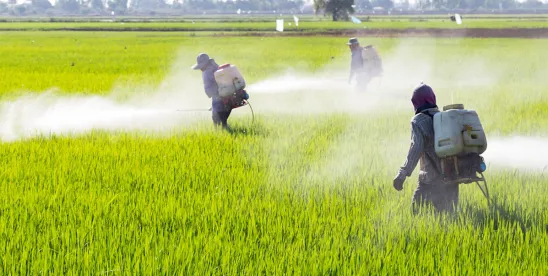On April 29, 2025, the U.S. Environmental Protection Agency (EPA) announced the release of its final Insecticide Strategy (Strategy), available here. EPA states in the Strategy that it is “intended to create a consistent, reasonable, transparent, and understandable approach to assess potential impacts and identify mitigations to reduce potential population-level impacts to listed species from the use of agricultural insecticides.” Specifically, EPA states that the Strategy identifies mitigations aimed at protecting more than 900 species listed by the U.S. Fish and Wildlife Service (FWS) that EPA considers when it registers a new insecticide or reevaluates an existing one.
According to EPA, the Strategy includes a three-step framework that EPA will use when reviewing pesticide applications or when a pesticide is undergoing registration review, including how to apply mitigations when needed. Generally, the three-step framework is as follows:
- Step 1. Establish the potential for population-level impacts to the listed species in categories — not likely, low, medium, or high. These categories indicate a potential concern for population-level impacts that may need mitigation.
- Step 2. – Use the potential of population-level impacts to invertebrates from Step 1 to identify levels of mitigations that reduce spray drift and runoff/erosion to non-target habitats.
- Step 3. Identify where in the conterminous United States the mitigations identified in Step 2 would apply.
EPA notes that it made several changes to the draft Insecticide Strategy that was released in July 2024 after review of public comments, and states its belief that the Strategy provides greater flexibility and options for the agricultural community, while ensuring that endangered species are protected. Some of the modifications include:
- Reducing buffer distances across all application methods;
- Separating spray drift and runoff exposure estimates to identify mitigation specific to each route of exposure, so that the level of mitigation is more consistent with the exposure calculation;
- Providing credit for any reduction in the proportion of a treated field for ground applications;
- Expanding mitigation menu options to allow credit for a reduction in boom length for aerial applications, artificial screens for airblast and ground applications, skipping last downwind row, use of axial deflectors, and targeted application equipment;
- Increasing mitigation points for higher sand soils;
- Developing a process to qualify conservation programs or standards that will give growers credit for the implementation of those programs for runoff and erosion mitigation needs;
- Developing a process to qualify external parties that would assess a grower’s farms and determine the existing mitigation points that could be achieved;
- Adding anionic polyacrylamide (PAM) as a new runoff and erosion mitigation option;
- Clarifying language on subsurface applications including alignment of language on subsurface chemigation with the mitigation menu website;
- Updating key data sources and identification of invertebrate species that may occur on agricultural fields; and
- Adding a Pesticide Use Limitation Area (PULA) group for generalist species that reside in wetlands to reduce mitigations applied outside of wetland habitats.
EPA notes that the Strategy does not impose any requirements on pesticide users and is not a rulemaking action. Instead, it represents a framework that EPA will use as it registers and re-registers pesticides. EPA may depart from the guidance in the Strategy “where circumstances warrant and may amend this strategy or its supporting documents when appropriate.”
Several trade associations voiced approval of the Strategy, stating that EPA’s coordination with the agricultural community allowed for “incorporating common sense improvements” to the Strategy. EPA states it will continue to work with stakeholders to modify and update the Strategy and related documents as additional information becomes available. In addition, EPA anticipates continued engagement with stakeholders to ensure effective implementation of the Strategy. Specific areas where EPA intends to undertake further engagement include the following:
- Developing a process to qualify individual conservation programs that could achieve nine mitigation points, and a process to qualify external parties that would assess a grower’s farm and determine the existing mitigation points that could be achieved during the growing season;
- Reconsidering using descriptions of protected areas or habitats, as opposed to (or to supplement) the descriptions of managed areas (e.g., what is not a protected area) in the Strategy;
- Developing refined PULA maps to limit the spatial extent of off-target mitigations to specific areas to protect listed species and to minimize impacts to applicators;
- Continuing to work with stakeholders to evaluate drift-reducing adjuvants as a mitigation measure for insecticides;
- Working with stakeholders to identify additional mitigation options including potential offset opportunities for insecticides and other types of pesticides; and
- Developing a mobile-friendly application tool for growers and other applicators that provides efficiencies in compiling the label information and helps pesticide users consider their options and understand how their current practices, location, and field properties relate to any required mitigations.
The Strategy and accompanying support documents, including a Response to Comments document and an updated Ecological Mitigation Support Document describing mitigations and supporting data that inform implementation of both the herbicide and insecticide strategies, is available at EPA-HQ-OPP-2024-0299.
Commentary
For some, the biggest surprise in this latest “strategy” for implementing Endangered Species Act (ESA) restrictions on pesticide decisions is that after a new Administration arrived in January, the fundamental outline of the approach EPA plans to use to evaluate insecticides is parallel to its earlier (that is, pre-election) approaches for evaluating herbicides. Following long-standing ecological assessment methods, EPA will require a certain number of “mitigation points” dependent on the review of ecological risks to species and their habitats as part of the risk assessment of the insecticide. The scheme is designed to prevent off-site migration through the air or soil, or as EPA has called it, “avoidance and minimization” of off-site movement toward habitats of threatened and endangered species (TES). The Strategy follows the outline, first announced in 2022, of how EPA planned to protect species, adding much more detail regarding how EPA will implement the avoidance and minimization approach that incorporates comments received generally on its overall plans and the herbicide strategy formulated before now.
This document continues to roll out EPA’s plans for categories of pesticides (e.g., insecticides, herbicides, rodenticides) with more detail regarding how the mitigation points system will be used on labels to protect species. Depending on the nature of the pesticide (e.g., estimated likelihood of off-site movement through the air or soil) and the possible risk to TES, a pesticide application would have to apply mitigation strategies, each of which could “earn” a number of points to avoid unacceptable exposure (movement) into species habitat according to EPA’s assessment. Examples of mitigation strategies could include, for example, applications using heavy droplet size to reduce drift to earn two points, contour plowing of the cropping area to earn three points, and different application buffers from species habitat worth various number of points. (Points are an important subject much discussed in the Strategy; in this 141-page document, the word “points” appears 227 times.)
This latest Strategy incorporates many changes from the first version applicable to herbicides, with more detail regarding how EPA incorporated comments received on the earlier strategy documents and as the results of meetings with stakeholders (e.g., growers, state agencies, academics, environmental groups, registrants).
While much more detailed and responsive to criticism than past iterations, there remains a number of outstanding issues about how these strategies will be applied and evaluated on specific crops and pesticides. Mitigation options which may be viable for a particular crop and pesticide will vary widely by geographic region and site-specific growing conditions (e.g., sandy soils, seasonal rainfall, time of year). The issue of the accuracy of species maps and the opportunity for refinements before mitigations are imposed remains controversial. Insecticide (or herbicide) use in orchards versus row-crops, irrigated or not irrigated crops, and even owned or leased land will have important differences affecting the feasibility of EPA’s point system. (For example, an applicator growing crops on leased land does not control the land use which otherwise may present mitigation options such as constructing wind breaks).
Overall, this document is much more detailed and refined about many issues identified in previous strategy documents. At the same time, there remain numerous questions about how or whether the approach can be effectively implemented. Not all growers using their current production systems and pest control strategies may be able to “get enough points.” EPA expects most to be able to do so, but the complexity of the labels may be daunting if not overwhelming, especially considering that growers often use more than one pesticide (an herbicide, and an insecticide, at different points in the growing cycle).
EPA, registrants, and state agencies are developing training materials and messaging to prepare the user community about the approach generally and what some of the requirements may be specifically. EPA may want to implement a phase-in or pilot period for some requirements in order to field-test label requirements and effectiveness. (Some observers cite an analogy to the imposition of enhanced Worker Protection Standards which increased farmworker protection requirements in the early 1990s.) This long-awaited integration of ESA and the Federal Insecticide, Fungicide, and Rodenticide Act (FIFRA) requirements will be an important program milestone, but its uncertain feasibility and production impacts may not avoid litigation or legislative challenges from stakeholders who remain dissatisfied.




 />i
/>i
